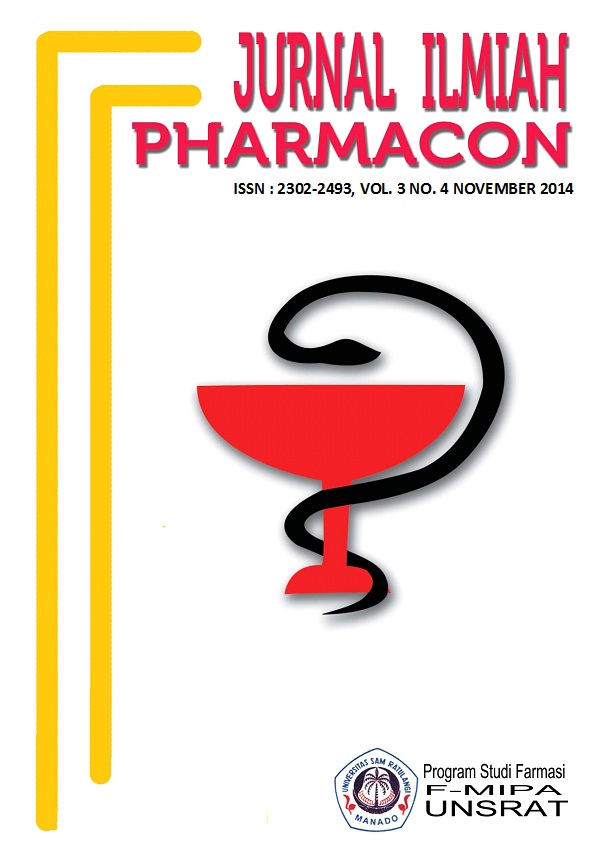2. KANDUNGAN FLAVONOID DAN AKTIVITAS ANTIOKSIDAN TOTAL EKSTRAK ETANOL DAUN KAYU KAPUR (Melanolepsis multiglandulosa Reinch f)
DOI:
https://doi.org/10.35799/pha.3.2014.6035Abstract
Kandungan Flavonoid dan Aktivitas Antioksidan Total Ekstrak Etanol Daun Kayu Kapur (Melanolepsis multiglandulosa Reinch f)
Alpha Cristyananda Damar1), Max Revolta John Runtuwene2), dan Defny Silvia Wewengkang2)
1)Program Studi Farmasi FMIPA UNSRAT Manado, 95115
2)Program Studi Farmasi FMIPA UNSRAT Manado, 95115
ABSTRACT
Â
This study aims to determine the flavonoid content and total antioxidant activity of the ethanol extract leavesKayu Kapur (Melanolepsis multiglandulosa Reinch f).Research done by differentiating treatment lime leaves into the sample fresh and dried samples were extracted in two different ways, namely maceration and soxhletasi were then tested total flavonoids and antioxidants.Calculation of total flavonoids were calculated using Chang, (2002) and for total antioxidant testing using Ferric Reducing Antioxidant Power (FRAP).Results showed total flavonoids in fresh and dried samples Extraction maceration was 11.97 mg / kg and 7.85 mg / kg and then to sample fresh and dry extraction soxhletasi is 9.71 mg / kg and 5.99 mg / kg.The antioxidant activity of fresh and dried samples was 9.39 mg / L gallic acid and 7.46 mg / L gallic acid, and then to sample fresh and dry extraction soxhletasi is 8.78 mg / L gallic acid, and 5.99 mg / L gallic acid.The highest content of flavonoids found in fresh samples with a total maceration extraction of 11.97 mg / kg and the highest antioxidant activity found in fresh samples with a total maceration extraction 9.39mg / L gallic acid.
Â
Keywords: Kayu Kapur (Melanolepsis multiglandulosa Reinch f), Antioxidant, total flavonoids, Ferric Reducing Antioxidant Power (FRAP)
Â
Â
ABSTRAK
Penelitian ini bertujuan untuk menentukan kandungan flavonoid dan aktivitas antioksidan total ekstrak etanol daun kayu kapur (Melanolepsis multiglandulosa Reinch f). Penelitian dilakukan dengan cara membedakan perlakuan daun kayu kapur menjadi sampel segar dan sampel kering diekstraksi dengan dua cara yang berbeda yaitu maserasi dan sokletasi yang kemudian diuji total flavonoid dan antioksidannya. Perhitungan total flavonoid dilakukan dengan menggunakan metode Chang, (2002) dan untuk pengujian total antioksidan menggunakan metode Ferric Reducing Antioxidan Power (FRAP). Hasil menunjukan total flavonoid pada sampel segar dan kering eksraksi maserasi adalah 11,97 mg/kg dan 7,85 mg/kg kemudian untuk sampel segar dan kering ekstraksi sokletasi adalah 9,71 mg/kg dan 5,99 mg/kg. Aktivitas antioksidan sampel segar dan kering adalah 9,39 mg/L asam galat dan 7,46 mg/L asam galat, kemudian untuk sampel segar dan kering ekstraksi sokletasi adalah 8,78 mg/L asam galat, dan 5,99 mg/L asam galat. Kandungan flavonoid tertinggi terdapat pada sampel segar ekstraksi maserasi dengan total 11,97 mg/kg dan untuk aktivitas antioksidan tertinggi terdapat pada sampel segar ekstraksi maserasi dengan total 9,39 mg/L asam galat.
Kata kunci : Kayu Kapur (Melanolepsis multiglandulosa Reinch f), Antioksidan, Total flavonoid, Ferric Reducing Antioxidan Power (FRAP)
Â
Downloads
Published
How to Cite
Issue
Section
License
Authors who publish with this journal agree to the following terms:
- Authors retain copyright and grant the journal right of first publication with the work simultaneously licensed under a Creative Commons Attribution License that allows others to share the work with an acknowledgement of the work's authorship and initial publication in this journal.
- Authors are able to enter into separate, additional contractual arrangements for the non-exclusive distribution of the journal's published version of the work (e.g., post it to an institutional repository or publish it in a book), with an acknowledgement of its initial publication in this journal.
- Authors are permitted and encouraged to post their work online (e.g., in institutional repositories or on their website) prior to and during the submission process, as it can lead to productive exchanges, as well as earlier and greater citation of published work (See The Effect of Open Access)










